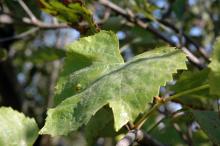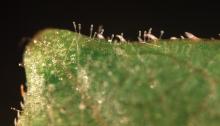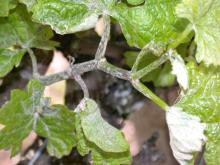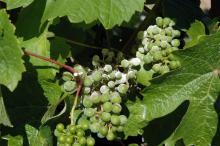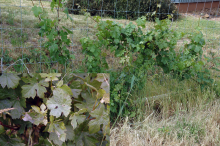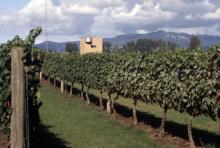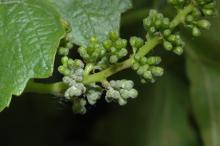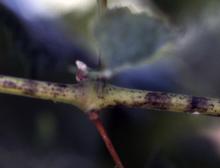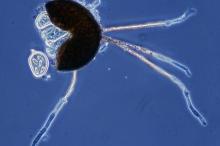See:
Grape (Vitis spp.) Relative Disease Susceptibility and Sensitivity to Sulfur
Cause Erysiphe necator (formerly Uncinula necator), a fungal disease common to all areas of the Pacific Northwest. The disease tends to be more severe on the west side of the Cascade Range but is a chronic problem in arid districts where over-the-canopy irrigation is used for early-season frost protection or watering. There is low tolerance to this disease on the fruit as it can impart negative tastes later in the wine. An infection of 3% to 5% of the berries results in an oily, viscous mouth feel in the wine. Vitis vinifera (European) cultivars are susceptible to powdery mildew while V. labrusca (American) cultivars are more resistant. Hybrids between the two species have various levels of resistance. Other hosts include Boston ivy, Virginia creeper, and Ampelopsis (porcelain berry). The fungus may overwinter as a group of thin threads called hyphae, inside the vine's dormant buds and/or as small black bodies (chasmothecia) on the exfoliating bark of the vine.
Buds on new shoots can be infected 4 to 6 weeks after shoots start growing but not after bud scales become suberized. These new infected buds remain quiescent until the next growing season. Shortly after budbreak, the fungus becomes active and covers the emergent shoot with a large white mass of mycelium ("flag shoots"). Flag shoots have rarely been observed in commercial western Oregon or eastern Washington vineyards.
Chasmothecia on the exfoliating bark release sexual spores during rainy weather above 50°F from budbreak through bloom. This weather also favors infection that results in individual powdery spots, called colonies, on the surface of leaves growing close to the bark.
Many asexual spores (conidia) are produced on the surface of powdery mildew colonies. Under optimal conditions of mild temperatures and high humidity, a single spore can germinate, infect the plant, and produce a new colony and a new crop of spores in 3 days. Temperatures over 85°F and/or sunlight (ultraviolet) inhibit conidia germination. Unfortunately, nighttime ultraviolet -C treatments do not perform adequately when used as the sole control measure but can complement fungicide management. Nights where temperatures fall below 40°F can damage colonies, increase the time new ones form, and reduce their size. Free water from rain and/or irrigation can wash conidia off a colony, burst conidia, or result in poor or abnormal germination of conidia. Formation of new chasmothecia occurs around veraison and into the fall.
Grape berries are highly susceptible from the time calyptras (hoods) fall off (BBCH 60) to shortly after bloom when berries are about pea size (BBCH 73 to 75). Susceptibility of the fruit drops rapidly after that time. Grapes do not get new infections on fruit after 8% Brix but can still have sporulation up to 15% Brix. Leaves and canes, however, can be infected up to and past harvest.
Symptoms Powdery mildew can attack all aboveground plant parts. In early stages, whitish or grayish patches are on leaves and, if severe, ultimately cover both surfaces. Colonies are more easily detected in full sunlight with the sun over your shoulder. Later in the season, the colony darkens and is peppered with minute black dots (chasmothecia). On fruit, the fungus at first may look grayish or whitish but later has a brownish, russeted appearance. Infected fruit cracks and drops from the cluster. Even blossoms sometimes can be infected, causing them to dry up or fail to set fruit. When green shoots and canes are infected, the affected tissues appear dark brown to black in feathery patches. Patches later appear reddish brown on the surface of dormant canes.
Flag shoots are difficult to detect. Some young shoots may be covered with a large white mass of mycelium. Others may have only a hint of thin threads on the shoot. Shoots generally are delayed in bud break and appear stunted and somewhat yellowed compared to healthy shoots. Can be confused with normal trichome density of young shoots of some cultivars.
Cultural control Activities and tactics that increase sunlight exposure to leaves and fruit reduce powdery mildew severity.
- Prevent excess vigor through proper selection of rootstocks, training systems, irrigation, and fertility for the vineyard site.
- Practice timely sucker control.
- Keep canes cut back close to the top wire of vertical trellises for better spray coverage.
- Removing leaves to manage bunch rot also helps fungicide cover the clusters, which helps manage powdery mildew.
- Manage sources of powdery mildew outside of the vineyard such as susceptible plants found in decorative gardens near tasting rooms or gazebos or volunteer vines along fence rows or riparian areas.
Chemical control Begin applications at 6 inches shoot growth and continue at regular intervals through the growing season. Strongest materials and shortest intervals should be used from prebloom (BBCH 57) through bloom and continued for 2 weeks after bloom. Adjusting application timing to coincide with early bloom (BBCH 61 to 65) has resulted in more consistent control of powdery mildew in western Oregon. A postharvest application may help control late-season infections in some years. Thorough coverage of all actively growing tissue is essential for good control. Do not extend application intervals in the Willamette Valley past 2 weeks.
Research in California has shown that sulfur sprays at budbreak initiate a release of ascospores and have some utility in overall disease management. Although this may occur in the more arid areas of the Pacific Northwest, it may not have the same utility in wetter areas west of the Cascade Range.
Resistance to many different fungicide groups has been documented for grape powdery mildew worldwide. Resistance to FRAC 3 and 11 fungicides has been documented in Oregon and Washington. Resistance to FRAC 7 and 13 fungicide products is also increasing. To prevent developing resistant fungi, alternate or tank-mix materials from different groups with different modes of action. Also, limit applications from any specific group to two (2) or fewer sprays. New York recommends to tank-mix FRAC 3 or 11 fungicides with sulfur or other products with a different mode of action. Several forecasting programs are available to help time applications (see below).
- Abound at 10 to 15.5 fl oz/A. Do not apply within 14 days of harvest or with silicone-based surfactants. Sprayers used to apply Abound should not be used on apples. Group 11 fungicide. 4-hr reentry.
- Aprovia at 8.6 to 10.5 fl oz/A plus an adjuvant. Do not use within 21 days of harvest. Group 7 fungicide. 12-hr reentry.
- Bicarbonate-based products. Might supplement a normal program when powdery mildew is first observed. Do not mix with acidifying agents. Only use early season since thorough coverage is essential and timed when disease pressure is low. O
- Kaligreen (82% potassium bicarbonate) at 2.5 to 5 lb/A. 4-hr reentry.
- MilStop (85% potassium bicarbonate) at 2.5 to 5 lb/A. Oregon and Washington only. 1-hr reentry.
- Monterey Bi-Carb Old Fashioned Fungicide at 4 teaspoons/2 gal water. H
- Cevya at 4 to 5 fl oz/A. Do not use within 14 days of harvest. When tank mixing with other products one might observe leaf injury on V. labrusca grapes. Group 3 fungicide. 12-hr reentry.
- Cinnerate at 16 to 45 fl oz/100 gal water plus an adjuvant. No reentry listed. O
- Copper formulations are registered but provide only moderate control alone. They are not generally recommended. O
- Dart at 25.6 to 44.8 fl oz/100 gal water. Spray with continuous agitation. 24-hr reentry. O
- Eagle 20 EW at 6 to 10 fl oz/A for home vineyard or landscape use. Do not apply within 14 days of harvest. Group 3 fungicide. 24-hr reentry. H
- EcoSwing at 1.5 to 2 pt/A. Can be used up to and including day of harvest. Group BM01 fungicide. 4-hr reentry. O
- Endura at 4.5 oz/A. Do not use within 14 days of harvest. Do not use for powdery mildew if you plan to use it for bunch rot. Group 7 fungicide. 12-hr reentry.
- Flint Extra at 3 to 3.5 fl oz/A. Do not use on 'Concord' grapes. Do not use within 14 days of harvest. Group 11 fungicide. 12-hr reentry.
- Fracture (BLAD) at 20.5 to 24.4 fl oz/A. Reapply if rain occurs within 12 hours of original application. Do not use within one day of harvest. Group BM01 fungicide. 4-hr reentry.
- Gatten at 6.4 fl oz/A. Do not use within 14 days of harvest. Group U13 fungicide. 12-hr reentry.
- Horticultural Mineral Oils. Generally effective from 1% to 2% volume to volume. Necrotic foliage may result if applied within 10 days of any sulfur application. Do not tank-mix with copper-based products when fruit is present. Do not use during freezing temperatures, above 90°F, or when plants are under heat or moisture stress. Do not use when foliage is wet because good coverage is essential. Do not use before bloom as it will have a negative impact on predatory mites. 4-hr reentry. O
- JMS Stylet Oil at 1 to 2 gal/100 gal water. Brix reductions have been observed in several locations when product is used all season.
- SuffOil-X at 1 to 2 gal/100 gal water.
- Kenja 400 SC at 20 to 22 fl oz/A. Do not use within 14 days of harvest. Group 7 fungicide. 12-hr reentry.
- Magister at 32 to 36 fl oz/A. Only one application allowed. Bees are very sensitive. Do not use within 7 days of harvest. Group 21A acaricide and group 39 fungicide. 12-hr reentry.
- Mettle 125 ME at 3 to 5 fl oz/A. Do not apply within 14 days of harvest. Group 3 fungicide. 12-hr reentry.
- M-Pede at 1 to 2 gal/100 gal water. Good coverage is essential. Do not use within 3 days of applying sulfur or past veraison. Do not mix with hard water. 12-hr reentry. O
- Oso SC at 6.5 to 13 fl oz/A. Do not use within 7 days of harvest. Group 19 fungicide. 4-hr reentry. O
- Ph-D WDG at 6.2 oz/A plus an adjuvant. May be applied on the day of harvest. Group 19 fungicide. 4-hr reentry.
- Prev-Am at 50 fl oz/100 gal water. Do not use with surfactants, above 90°F, or when plants are under heat or moisture stress. 24-hr reentry.
- Problad Verde at 18.1 to 45.7 fl oz/A. Reapply if rain occurs within 12 hours of original application. Do not use within one day of harvest. Group BM01 fungicide. 4-hr reentry.
- Procure 480 SC at 4 to 8 fl oz/A. Do not use within 7 days of harvest. Group 3 fungicide. 12-hr or 24-hr reentry depending on activity.
- Prolivo 300 SC at 4 to 5 fl oz/A. Can be used day of harvest. Group 50 fungicide. 4-hr reentry.
- Quadris at 10 to 15.5 fl oz/A. Do not apply within 14 days of harvest or with silicone-based surfactants. Sprayers used to apply Abound should not be used on apples. Group 11 fungicide. 4-hr reentry.
- Quintec at 4 to 6.6 fl oz/A. A surfactant is not required when used alone but a nonionic surfactant is preferred if needed for tank-mixes. Do not apply within 21 days of harvest. Group 13 fungicide. 12-hr reentry.
- Rally 40 WSP at 3 to 5 oz/A. Do not apply within 14 days of harvest. Group 3 fungicide. 24-hr reentry.
- Regalia at 1 to 4 quarts/A plus another fungicide. Use on 7-day intervals. May be used day of harvest. Does not benefit from the addition of an adjuvant. Group P5 fungicide. 4-hr reentry. O
- Rex lime sulfur (28%) at 0.5 to 0.75 gal/100 gal water. May be used day of harvest. 48-hr reentry. O
- Rhyme at 4 to 5 fl oz/A. Can be used through a drip or microsprinkler system at higher rate. Do not use within 14 days of harvest. Group 3 fungicide. 12-hr or 5 day reentry depending on activity.
- Sil-Matrix at 1 to 4 quarts/100 gal water plus a nonionic surfactant. Can be applied the day of harvest. 4-hr reentry. O
- Sovran at 3.2 to 4.8 oz/A. Rotate with other fungicides that have different modes of action. Do not use within 14 days of harvest. Do not use organosilicate surfactants. Some sweet cherries, such as 'Van', may be injured if accidentally sprayed. Group 11 fungicide. 12-hr reentry.
- Spectracide Immunox Multi-Purpose Fungicide Spray Concentrate for Gardens at 1.25 fl oz/gal water. Do not use within 2 weeks of harvest or more than five (5) times per season. Group 3 fungicide. H
- Sporan EC2 at 1.5 to 3 pints/100 gal water/A plus an adjuvant. Do not use when temperature equals or exceeds 90°F. May be used up to and including the day of harvest. Group BM01 fungicide. No reentry listed. O
- Sulfur products. Do not extend intervals beyond 14 days. Sulfur can burn foliage when applied above 85°F. The temperature relationship is correlated with increases in the daily maximum, within a few days after application. Grapes in California can withstand sulfur applications (at lower rates) above 85°F if there is no major short-term changes in the daily maximum. May injure labrusca types like 'Concord'. Do not use within two weeks of an oil spray. Hydrogen sulfide in the wine may increase if used within 35 days of white-wine harvest or within 50 days of red-wine harvest. Wettable powder formulations are less likely to result in hydrogen sulfite in the wine than micronized formulations. Addition of a spreader sticker adjuvant may be helpful. Group M2 fungicides. 24-hr reentry. O
- Microthiol Disperss (80% sulfur) at 3 to 10 lb/A. Do not use a spreader-sticker. Use at 7- to 14-day intervals.
- Safer Brand Garden Fungicide (12% sulfur) at 2 fl oz/gal water. Thoroughly sprayed over the entire plant. Do not use within 21 days of harvest. H
- Thiolux (80% sulfur) at 3 to 10 lb/A.
- Tebucon 45 DF at 4 oz/A. Do not apply within 14 days of harvest. Group 3 fungicides. 12-hr reentry.
- TopGuard SC at 8 to 10 fl oz/A. Can be used through drip or micro sprinkler systems. This rate can only be used twice per season. Do not use within 14 days of harvest. Group 3 fungicide. 12-hr to 5-day reentry depending on activity.
- Topsin M WSB at 1 to 1.5 lb/A plus another fungicide. Do not use within 7 days of harvest. Resistant fungi make this product ineffective and may be prevalent in many vineyards. Group 1 fungicide. 2-day reentry.
- Torino at 3.4 oz/A. Do not use within 3 days of harvest. Or Torino can be used once at 6.8 oz/A with a 7-day preharvest interval. Group U6 fungicide. 4-hr reentry.
- Trionic 4 SC at 4 to 8 fl oz/A. Do not use within 7 days of harvest. Group 3 fungicide. 12-hr to 24-hr reentry depending on activity.
- Vacciplant at 14 to 60 fl oz/A plus an effective fungicide. Can be used day of harvest. Unknown efficacy in the PNW. Group P4 fungicide. 4-hr reentry.
- Vivando at 10.3 to 15.4 fl oz/A. Do not use with horticultural oils, or use within 14 days of harvest. Group 50 fungicide. 12-hr reentry.
Combination Fungicides
- Aprovia Top at 8.5 to 13.3 fl oz/A. Do not apply within 21 days of harvest. Group 3 + 7 fungicide. 12-hr reentry.
- Inspire Super at 16 to 20 fl oz/A. Do not use within 14 days of harvest or on 'Concord'. Group 3 + 9 fungicide. 12-hr reentry.
- Luna Experience at 6 to 8.6 fl oz/A. Do not use on 'Concord' or within 14 days of harvest. Group 3 + 7 fungicide. 12-hr to 5-day reentry depending on activity.
- Luna Sensation at 7 fl oz/A. Do not use for powdery mildew control if already used for bunch rot control. Do not use on 'Concord' or within 45 days of harvest. Group 7 + 11 fungicide. 12-hr reentry.
- Luna Tranquility at 14 fl oz/A. Do not use for powdery mildew control if already used for bunch rot control. Do not use within 45 days of harvest or after BBCH 73. Group 7 + 9 fungicide. 12-hr reentry.
- Merivon at 4 to 5.5 fl oz/A. Do not mix with any other materials, use within 14 days of harvest, or on cultivars such as Concord or Niagara. Group 7+11 fungicide. 12-hr reentry. 12-hr to 5-day reentry depending on activity.
- Miravis Prime at 9.2 to 13.4 fl oz/A. Do not use for powdery mildew control if already used for bunch rot control. Do not use within 14 days of harvest. Group 7 + 12 fungicide. 12-hr reentry.
- Pristine at 8 to 12.5 oz/A. Do not use within 14 days of harvest, or more than five (5) times/year. Do not use on labrusca type grapes such as 'Concord' due to possible foliar injury. Group 7 + 11 fungicide. 12-hr or 5-day reentry based on activity.
- Quadris Top at 12 to 14 fl oz/A. Do not apply within 14 days of harvest or on 'Concord' grapes. Group 3 + 11 fungicide. 12-hr reentry.
- Regev at 4 to 8.5 fl oz/A. Do not apply within 2 days of harvest. Group 3 + BM01 fungicides. 12-hr reentry.
- Topguard EQ at 5 to 6 fl oz/A. Do not use with silicone surfactants or within 14 days of harvest. Sprayers should not be used on apples. Group 3 + 11 fungicide. 12-hr to 5-day reentry depending on activity.
Note If you are trying to bring an abandoned vineyard back into production, spraying lime sulfur (such as Rex lime sulfur (28%) at 6 to 12 gal/A) during the dormant season or micronized sulfur at 100% budbreak may help bring powdery mildew under control with a normal, season-long spray program.
OxiDate 5.0 is registered as a curative or rescue application but it only has short residual activity.
Although Revus and Revus Top are registered, they contain a chemical for control of downy mildew, a disease not found on grape in the PNW and thus is not recommended for use.
Some registered products offer only suppression of this disease and thus are not recommended for use. These products include Howler and Intuity.
Forecasting Several forecasting programs are available for scheduling fungicide applications. The standard Oregon phenology-based program begins applications at 6 to 8 inches shoot growth and continues at regular intervals based on grapevine development. The Gubler-Thomas (UC-Davis) program uses leaf wetness and temperature early in the year to predict ascospore infection periods and only temperature during the summer to predict conidial infection periods. The New York (Gadoury) program is based on rainfall and temperature. The Kast (Oi Diag) program incorporates relative humidity along with temperature and rainfall. All programs have been effective at timing fungicides and controlling powdery mildew in western Oregon. Additional models have been developed in Canada (Carisse) and Italy (Caffi). An ascospore release model for western Oregon incorporates leaf wetness, temperature, precipitation, and relative humidity but was only 66% accurate. The use of rose bushes at the end of rows is based only on anecdotal accounts and has no basis in the scientific literature.
Biological control Short intervals such as 7 days between applications is recommended especially during bloom. More effective when combined with leaf removal practices and integrated with sulfur or synthetic fungicides at bloom. Do not use as a stand alone program, especially early season.
- Actinovate AG (Streptomyces lydicus strain WYEC 108) at 3 to 12 oz/A plus a spreader-sticker. Do not mix with Regalia or certain copper or sulfur-based products. California trials averaged 50% control in 5 trials. Poor control in western OR trials. 4-hr reentry. O
- Aviv (Bacillus subtilis strain IAB/BS03) at 10 to 30 fl oz/100 gal water. Did not improve control when tank mixed with a low rate of sulfur. Preharvest interval not specified. 4-hr reentry. O
- Double Nickel 55 (Bacillus amyloliquefaciens strain D747) at 0.25 to 3 lb/A. May be used day of harvest. Poor control in western Oregon. Group BM02 fungicide. 4-hr reentry. O
- Howler Evo (Pseudomonas chlororaphis strain AFS009) at 20 to 120 oz/A plus a surfactant. Can be used day of harvest. Poor control in western Oregon. 4-hr reentry. O
- LifeGard WG (Bacillus mycoides isolate J) at 4.5 oz/100 gal water. Does not have direct activity on pathogens but stimulates host defenses. Did well when used in a program with sulfur during bloom. Group P06 fungicide. 4-hr reentry. O
- Serenade OPTI (Bacillus subtilis strain QST 713) 14 to 20 oz /A plus another fungicide such as sulfur. Active ingredient is a small protein. May be used day of harvest. Ineffective as a standalone treatment based on tests in western Oregon. 4-hr reentry. O
- Serenade Garden Disease Control Concentrate at 2 to 4 fl oz/gal water. Ineffective as a standalone treatment based on tests in western Oregon. H O
- Serifel (Bacillus amyloliquefaciens strain BMI 600) at 4 to 16 oz/A. May be used day of harvest. Unknown efficacy. 4-hr reentry. O
- Sonata (Bacillus pumilis strain QST 2808) at 2 to 4 quarts/A plus a spreader-sticker. May be applied up to and including the day of harvest. 4-hr reentry. O
- Stargus (Bacillus amyloliquefaciens strain F727) at 1 to 4 quarts/A plus a nonionic surfactant. May be used day of harvest. Variable results in western Oregon tests. 4-hr reentry. O
- Theia (Bacillus subtilis strain AFS032321) at 1.5 to 5 lb/A. May be applied up to and including the day of harvest. Good results in western Oregon tests. 4-hr reentry. O
References Kwasniewski, M. T., Sacks, G. L., and Wilcox, W. F. 2014. Persistence of elemental sulfur spray residue on grapes during ripening and vinification. American Journal of Enology and Viticulture 65:453-462.
Thiessen, L.D, Neill, T.M., and Mahaffee, W.F. 2018. Assessment of Erysiphe necator ascospore release models for use in the Mediterranean climate of western Oregon. Plant Disease 102:1500-1508.
Wong, A. T., Gadoury, D. M. and Mahaffee, W. F. 2024. Evaluation of germicidal UV-C light for suppression of grape powdery mildew and Botrytis bunch rot in Western Oregon. Plant Disease, 108:2894-2905.



